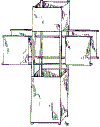By Leslie Hunt

FIG. 59.
CROSS KITE COMPLETE
Nearly all the square crosses, such as are used for lodge emblems, may be made by bowing the vertical member, leaving the horizontal member plane. Sometimes a keel on the back will have to be added. Should one of the slender crosses be desired, the box principle should be used. The more common types of crosses are shown in Figure 58.

Fig. 58.
VARIOUS TYPES OF CROSSES THAT HAVE POSSIBILITIES IN KITE DESIGN
F is similar to E, except the ends are shaped as shown.
Some of these are used for religious and fraternal ceremonies, but others are merely decorative designs and may be used where others would not be appropriate. Consult an illustrated dictionary for the names of these designs.
The bridle will work well if attached to the uprights near the upper cross stick. Notice the cross wings are not papered on top.
Styles A to F are built according to the method about to be described. Most of the letters of the alphabet may be constructed in the same way and will fly fairly well with a little special attention.
Prepare eight sticks 1/4 by 3/8 by 26 inches. Lap the sticks 4 inches, glue and wrap, making four sticks 48 inches long. Using these as uprights, construct a rectangular box kite having a 12-inch face and a 6-inch depth. The top paper should be 10 inches and the bottom paper 20 inches wide.
The diagonal sticks should measure 13 inches from notch to notch, and should have the ends finished as described in Figure 39. The diagonals should rest on chips glued to the uprights as described in The Square Box Kite.

FIG. 60.
SUGGESTION FOR A LETTER KITE BASED ON THE BOX-KITE AND CROSS-KITE
PRINCIPLES
Prepare two sticks in the same manner as the uprights bringing their length to 36 inches. Lash one stick to the front upright, allowing an equal amount to project on each side of the kite. The stick should be fixed in position 12 inches from the top. The other stick should be similarly placed 12 inches farther down. Frame 10 inches of the ends of these sticks and paper neatly. Another pair of wings may be used on the back Cross Kite complete. One made by the author rated .90 ounce uprights, but it will be found that the additional pair contributes but little to the behavior or appearance of the kite.
The bridle should be attached to the intersections of the uprights and upper cross sticks. The style described is the single-arm Latin Cross, but others may be made on the same general plan.
The Latin Cross is very pretty when made of white crepe paper and decorated with artificial snow, especially if flown at night and illuminated with an automobile spotlight. Such a flight is very appropriate at Easter. Figure 59 shows the cross kite complete. It rated .90 ounce per square foot of effective surface. It was a good flier.
Style B, Figure 58, may be used for Christmas Seal advertising, and Style H may be worked up for Red Cross drives.
Of course, kites designed to make an appeal to the finer feelings of the spectators should be tried out carefully in private lest they dash down and spoil the effect they are supposed to make when flown in public.
Letters, if only a few are needed, may be made on the box principle. Figure 60 shows the plan for the letter A, but if the number of letters is considerable, they should be made flat, attached to a light frame and flown with a tail as in Figure 61.

FIG. 61.
SUGGESTION FOR A GROUP OF LETTERS TO BE PAPERED ON A FRAME AND FLOWN WITH A TAIL
The squares are 2 inches square and are made with light strings. Do not stretch the strings too tight. Dark blue or black mosquito netting is excellent for kites of this kind. Bridles are to be attached in the manner described under the Plane-Surface Kites.